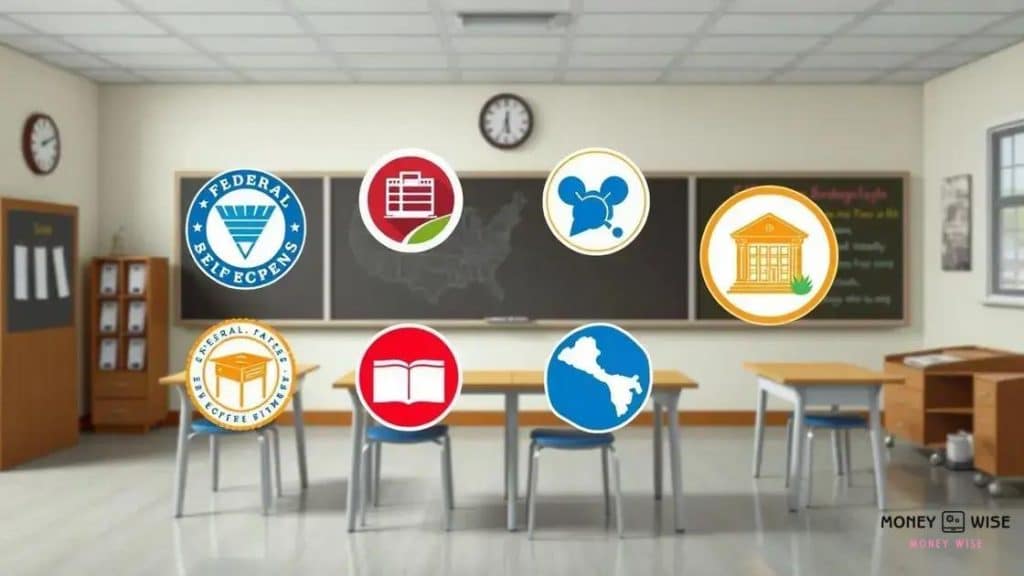State vs. federal control in education: what’s at stake?

State vs. federal control in education involves a complex balance where state policies allow local autonomy, while federal funding and mandates aim to ensure accountability and equal educational resources across the nation.
State vs. federal control in education is a topic that sparks debate among educators and policymakers alike. Have you ever wondered how these layers of governance impact what students learn? Let’s dive into this essential conversation.
Understanding the role of federal education policies
Understanding the role of federal education policies is crucial in today’s educational landscape. These policies shape teaching and learning experiences across the nation. They create standards and guidelines that states must follow to ensure all students receive a quality education.
Key Federal Policies
Some vital federal education policies include:
- No Child Left Behind Act
- Every Student Succeeds Act
- Individuals with Disabilities Education Act
Each of these policies plays a significant role in ensuring that educational systems operate effectively and equitably. The No Child Left Behind Act, for instance, emphasized standardized testing as a measure of success, impacting how schools approach teaching.
Impact on States
Federal policies influence state education systems greatly. States must align their educational initiatives with these federal mandates to receive funding. This often leads to an atmosphere where state officials must balance local needs with broader federal requirements. Federal funding can provide essential resources for schools but also comes with strict guidelines that must be adhered to.
- Access to educational resources
- Teacher development programs
- Support for underfunded schools
Moreover, these policies often require states to report on student performance and progress, which can shape the curriculum. This creates a landscape where federal influence often feels overwhelming to educators striving to meet varying local needs.
As educators and stakeholders work within these frameworks, a key question arises: how can states retain their unique educational identity while complying with federal education policies? It’s a delicate balance that requires thoughtful dialogue and collaboration.
The benefits of state control in education

State control in education offers a range of benefits that can enhance the learning experience for students. By allowing states to set their own educational policies, they can address the unique needs of their communities.
Tailored Educational Approaches
One significant benefit is the ability to create tailored educational approaches. States can develop curricula that reflect local culture and values. This flexibility helps educators create relevant and engaging content for students.
- Integration of local history and culture
- Customization of learning materials
- Adaptation of teaching methods to student needs
These tailored approaches can lead to better engagement among students, making learning more meaningful. Each student has different strengths and interests, and state control allows for a diverse range of educational options.
Responsive to Community Needs
Another key advantage is that states can be more responsive to community needs. For instance, if a particular area has a high demand for technology skills, that state can prioritize vocational programs in those fields.
- Local job market alignment
- Community involvement in educational decisions
- Responsive funding allocation
This connection to the local job market ensures that students are equipped with skills that are relevant and in demand, leading to greater employment opportunities after graduation.
Furthermore, state control can foster a sense of accountability and involvement. When local stakeholders, such as parents and community leaders, have a voice in education, it builds trust and cooperation. This collaborative spirit can enhance the overall quality of education and promote better student outcomes.
Key differences between state and federal education systems
The key differences between state and federal education systems shape how education is delivered and managed across the United States. Recognizing these differences is vital to understanding the educational landscape.
Governance Structure
One major difference lies in the governance structure. State education systems are controlled by local authorities, such as school boards and state education departments. In contrast, the federal education system sets overarching policies and standards but has limited direct control over schools.
- State systems focus on local governance.
- Federal systems establish nationwide policies.
- State systems can implement programs reflecting local needs.
This means states can tailor their educational approaches based on their unique populations, while federal policies aim to ensure a baseline of educational quality across all states.
Funding Mechanisms
Another significant difference is how funding is allocated. State education systems primarily rely on local and state taxes, which often leads to disparities in funding between wealthier and poorer areas.
- Local property taxes fund most state schools.
- Federal funding supplements but doesn’t replace state funding.
- State disparities can affect educational resources and opportunities.
On the other hand, federal education funding typically comes with specific mandates that states must follow, tying financial support to compliance with federal guidelines.
When it comes to curriculum and standards, states have more control over what is taught. They can develop their own academic standards and assessments. However, federal education systems often promote standardized testing to measure progress and accountability.
Challenges in balancing state and federal control
Balancing state and federal control in education presents several challenges that can impact both students and educators. Understanding these challenges is essential to navigating the complex educational landscape.
Conflicting Policies
One major challenge arises from conflicting policies between state and federal levels. States may create their own educational standards that differ from federal requirements. This inconsistency can create confusion for teachers and administrators.
- Different testing requirements across states.
- Variability in curriculum standards.
- Misalignment of educational goals.
Such conflicts can lead to complications in the educational process, where educators have to adapt to shifting regulations without clear guidance.
Funding Inequities
Funding is another significant issue in balancing control. Federal funding often comes with stringent requirements that may not align with state priorities. States are pressured to follow federal guidelines to secure funding, which can create disparities in how education is funded across different regions.
- Funding based on compliance with federal policies.
- Local taxes primarily support state funding.
- Wealthier areas may have more resources to meet federal standards.
This results in disparities where some states may struggle to meet federally mandated goals while others excel. Furthermore, the reliance on federal funding presents a constant risk of losing financial support if policies are not met.
Moreover, the tension between federal oversight and state autonomy can hinder innovation in local education systems. States may feel constrained by federal mandates, which can prevent them from exploring unique approaches that address local needs.
Impact of federal funding on state education systems
The impact of federal funding on state education systems is significant and multifaceted. Federal financial support plays a crucial role in shaping how education is delivered in various states.
Funding Initiatives and Programs
Federal funding often targets specific initiatives and programs aimed at enhancing educational outcomes. For example, programs like Title I provide financial assistance to schools with a high percentage of students from low-income families. This funding is essential for:
- Improving educational resources in underfunded schools.
- Implementing early childhood education programs.
- Providing professional development for teachers.
Such initiatives can lead to improved student performance and greater equity in education, as they help bridge the gap between affluent and low-income districts.
Compliance and Accountability
While federal funding can provide much-needed resources, it often comes with strict compliance guidelines. States must adhere to federal mandates to secure and maintain funding. This relationship can create pressure on educational authorities to follow specific protocols, such as standardized testing, which may not always align with local educational goals.
- Requirement for standardized testing and assessments.
- Accountability measures tied to federal funding.
- Pressure to meet federal performance benchmarks.
This situation can be a double-edged sword, as it promotes accountability but can also stifle local innovation and flexibility.
Additionally, federal funding is subject to political changes. Shift in administration can alter budget allocations, impacting state education funding levels. States that depend heavily on these funds may face uncertainty in maintaining programs and services essential to student success.
State control allows for local needs and cultural relevance, while federal funding ensures resources and accountability. Understanding these dynamics can help educators, policymakers, and communities work together for better educational outcomes. Finding the right balance is essential for fostering a strong education system that benefits all students.
FAQ – Questions Frequently Asked about State vs. Federal Control in Education
What is the main difference between state and federal control in education?
The main difference lies in governance: state control allows local authorities to set policies, while federal control sets nationwide standards.
How does federal funding impact state education systems?
Federal funding can provide essential resources but often comes with strict requirements that states must follow to secure those funds.
What are some benefits of state control in education?
State control allows for tailored educational approaches that reflect local culture and needs, promoting community engagement in schools.
What challenges arise from balancing state and federal control?
Challenges include conflicting policies, funding inequities, and the tension between maintaining local flexibility and complying with federal mandates.
How can communities get involved in education policy?
Communities can influence education policy by participating in school board meetings, advocating for local initiatives, and collaborating with educators.





